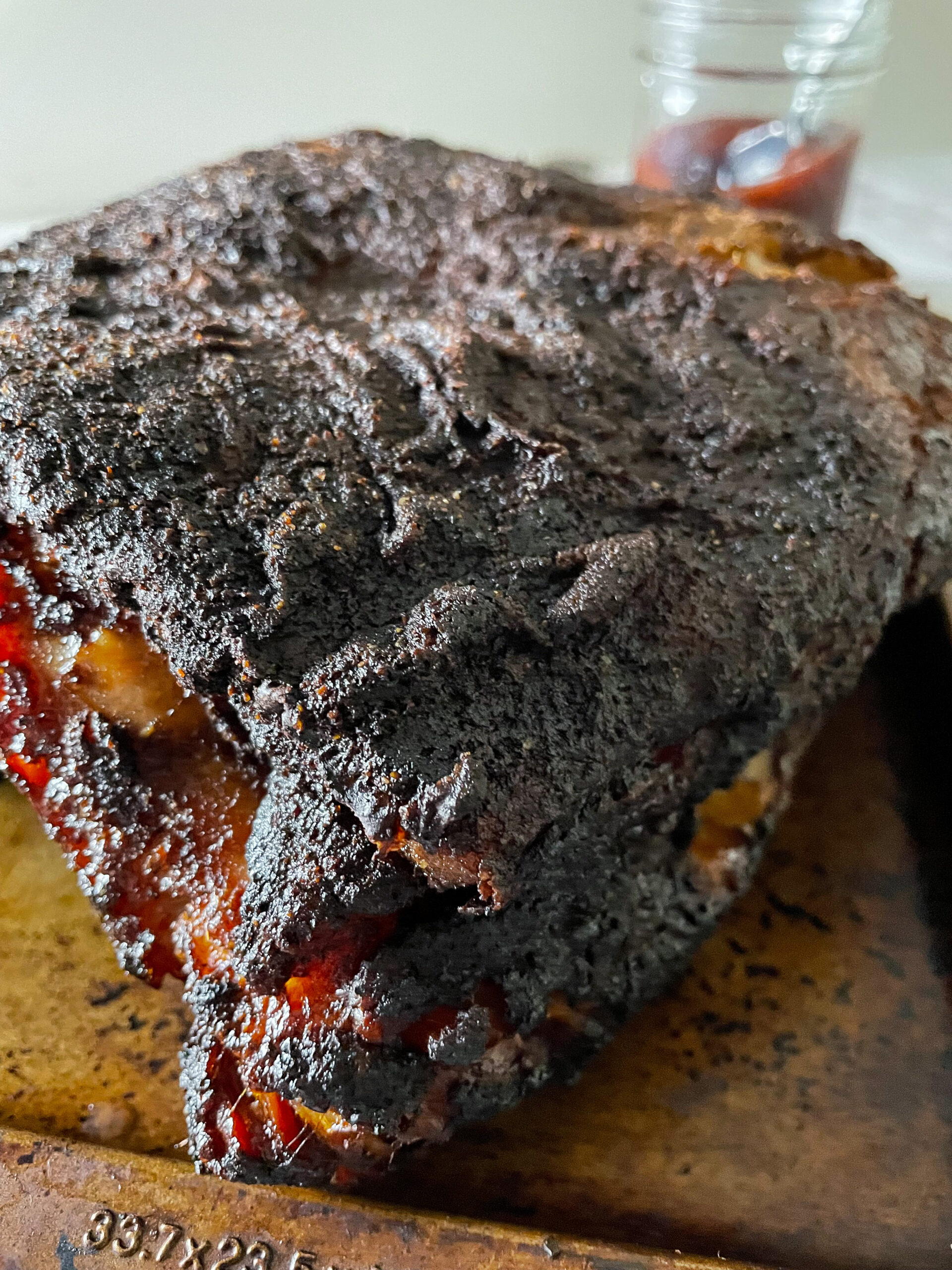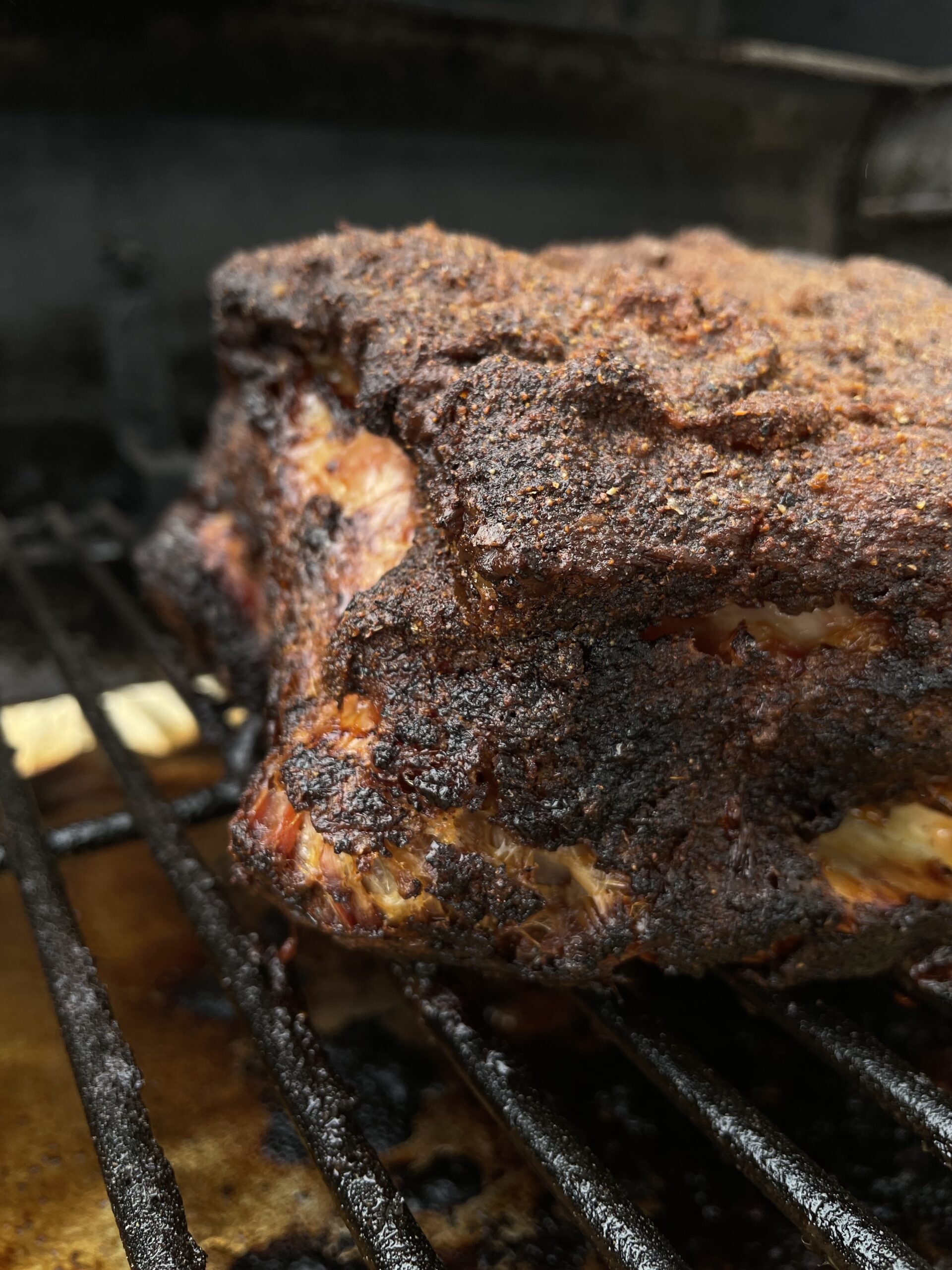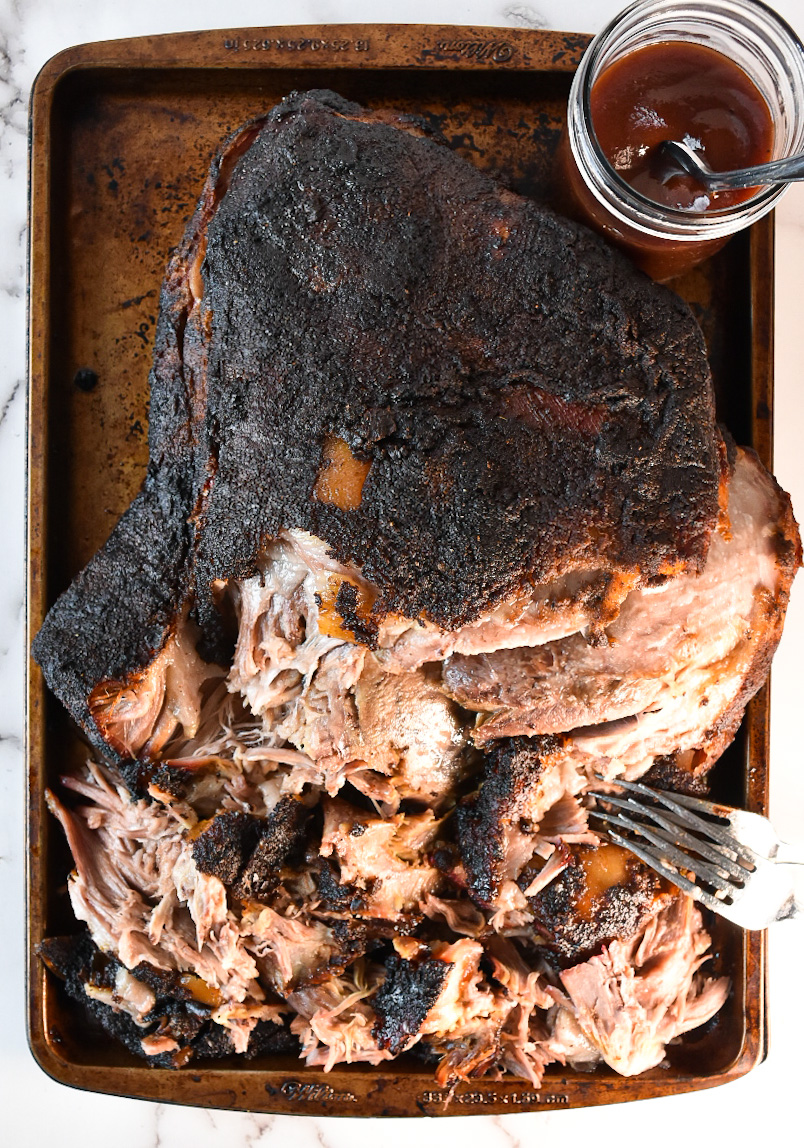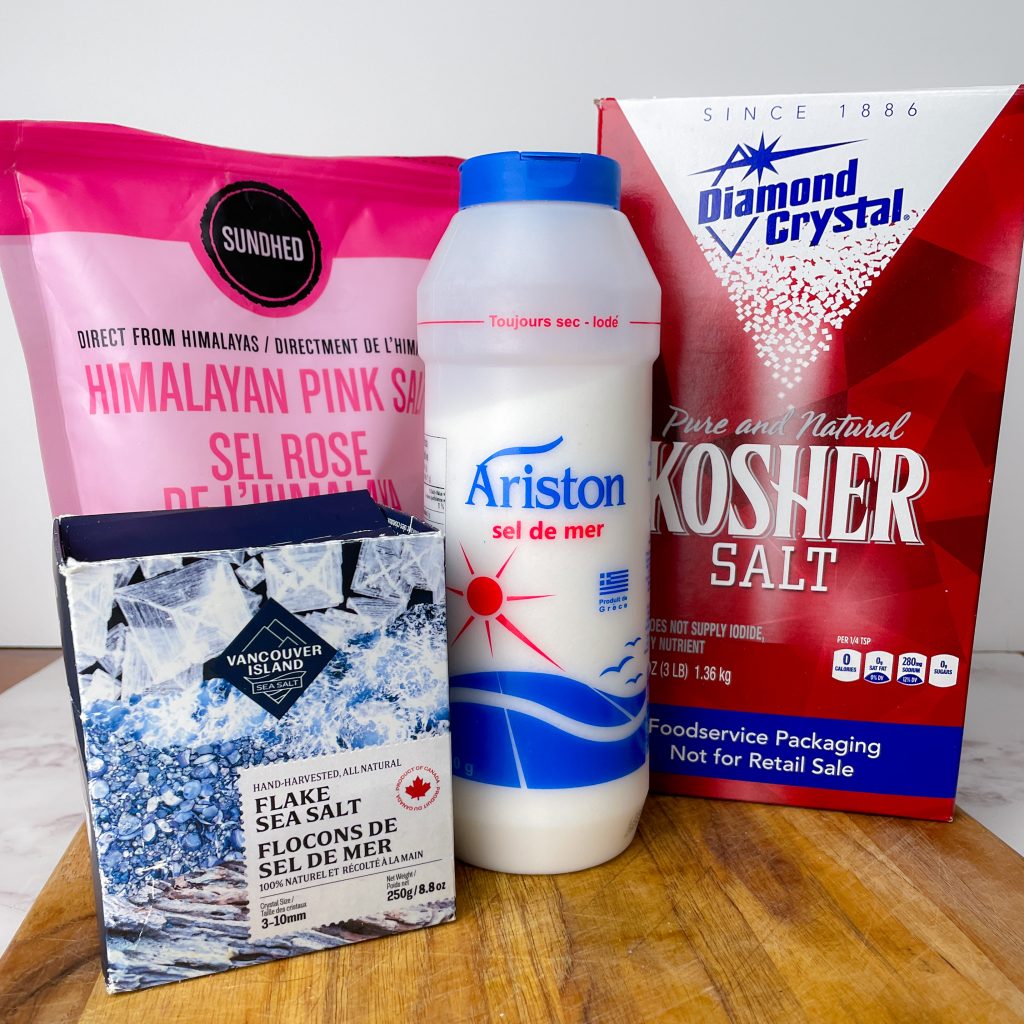This simple, smoked pulled pork recipe is great for feeding a hungry crowd or your family. With ingredients that you have in your kitchen, you can have that classic, big smoke meat with a dark bark and plenty of flavour. All you need is a few basic ingredients, a trusty smoker and time!
Keep reading for our tips on pulling off the best smoked pulled pork. Scroll to the end for the full smoked pulled pork recipe.
What Kind of Smoke Do You Use for Pulled Pork?
Pork is versatile and works well with any type of wood for smoking. We like a blended pellet mix like this one because the flavours pair well with any meats you might be smoking. That being said, pork pairs particularly well with hickory or maple and even sweet woods like apple, pecan or cherry.

What is the Best Cut of Meat for Pulled Pork?
Most pulled pork is made using bone-in pork butt, which isn’t actually from the butt at all (confusing right?). Pork butt is from the shoulder; a hard-working muscle group that is perfectly suited to low and slow cooking (like this Pulled Pork Recipe we’re sharing below). Pork butt tends to be rectangular in shape and marbled with lots of intra-muscular fat.
Pork butt is the best option for pulled pork. You can use picnic shoulder for pulled pork, however this cut is best suited for recipes that feature crispy pork skin or crackling. Picnic shoulder is triangular in shape, less fatty, and best as a pork roast (with crackling).
Do You Leave the Fat Cap on Pulled Pork?
Your butcher can custom cut the pork butt to your liking and size. You can choose to have your pork butt as a boneless or bone-in butt roast. Most grillers choose to go with a bone-in pork butt because the bone imparts flavour and the bone is easily removed once the meat is tender. You can also discuss the size of the fat cap with your butcher (or trim it at home). Most people prefer the fat cap to be about ¼ inch thick. You don’t want to remove it completely as the fat helps retain moisture and adds flavour.
What Size of Pork Butt Do I Need for Pulled Pork?
We can determine what size of pork butt you need with a quick calculation. Typically, one person will eat 1/3 pounds of cooked pulled pork (which is equivalent to 2/3 pounds of raw meat). Knowing this we can multiply the number of guests by 0.66 (2/3 lbs) to get the amount of raw pork butt required. For example, 10 guests you will need about 6.6 lbs of pork butt.

Homemade Spice Rub for Pulled Pork
Many spice rubs contain sugar and we wanted to show you that you can make a delicious savoury rub without sugar (pulled pork spice rub recipe below!). Contrary to popular belief, sugar is not needed in your spice rub to achieve a nice dark bark. Plus, without sugar, you don’t have to worry about charring the sugar if your smoker gets too hot (not a pleasant taste!).
And knowing that pulled pork is typically served with a sweet BBQ sauce, it’s nice to keep the rub on the savoury side to balance out the flavours.
Spritzing Pulled Pork
Wondering why you should spritz your pork butt while it’s smoking? Spritzing is intended to add layers of flavour to your meat. It’s also to help retain some moisture and attract smoke to the surface of the meat (smoke likes wet surfaces). Spritzing with sweet liquids will caramelize on the meat, which also contributes to flavour. Just don’t overdo the sugars in your rub and spritzer – you don’t want it to char.
Too busy for spritzing? Don’t worry, you can skip this step and still have a really delicious pulled pork. Pork butts tend to have lots of fat which bastes the meat, keeping it moist and delicious!
Do You Smoke a Pork Butt Fat Side Up or Down?
We’ve stuck with the traditional fat-side up for this recipe but others would debate placing the pork butt fat-side down is the way to go. Which way is best? We’ll let you try each method and decide because they each have their benefits!
Placing the pork butt with the fat-side up allows for the fat to baste the meat as it melts. Contrarily, placing the fat-side down is thought to protect the meat from the heat source and prevent it from drying out (assuming your heat source is below the meat). Give it a try and see what you think!

What is Bark on Pulled Pork?
Bark is that dark, tasty crust that forms on the outside of smoked meat. It appears through chemical reactions called the Maillard reaction and polymerization. The Maillard reaction is a reaction between sugars and proteins that occurs upon heating and that produces browning of some foods. This reaction begins when the surface of the meat starts to dry out and results in a hard layer on the meat called the pellicle. The addition of the spice rub layer with the pellicle forms the bark.
How do you get a good bark on pulled pork?
The formation of bark on a pork butt requires smoke, the proper temperature and a spice rub. Here are some of our thoughts on developing a good bark on your pork butt.
Tips to Get a Good Bark:
- Temperature is important in the formation of bark. Maintain a temperature between 225˚-250˚F (too low and the bark won’t form, too high and the meat will char)
- Set the meat directly on the grill grates for maximum surface area contact with the air and smoke (don’t set the pork butt in a pan)
- Sugar can char your meats, be cautious with the use of sugar.
- Don’t wrap the pork butt too soon otherwise you will damage the bark formation and the pork butt will steam in its juices (resulting in mushy and not as flavourful pulled pork). If you choose to wrap your pork butt, do it once you see that the pork butt has darkened in colour (bark forming).
- Don’t spritz the pork butt for the first three hours to allow the crust time to form
- Leave the right amount of fat, fat is good for moisture and flavour but too much fat can hinder the creation of the pellicle by obstructing access of the heat and oxygen to the proteins
- Smoke is important in the formation of bark, as the smoke particles stick to the glaze and darken the meat

What Temperature Does Pulled Pork Stall At?
When your pork butt reaches a temperature of around 150˚F – 165, you may notice that the temperature stops rising (and could stay this temperature for hours). When the temperature plateaus, this is known as the stall phase. In this period, the moisture in the meat is evaporating and making its way to the surface which has a cooling effect of the meat. This cooling effect prevents the meat temperature from rising.
During the stall, it may be tempting to foil wrap your pork butt to speed up cooking. However, wrapping your pork butt at this point will inhibit the crust formation.
How Long Does Pulled Pork Stall?
How to get out of the stall? All it needs is time. Trust us, it’s worth the wait! Once enough moisture has evaporated, the temperature of the meat will continue to rise again.

Should You Wrap Pulled Pork?
Wrapping your pork butt in the final stages of cooking is not required and not all pitmasters take this step. Wrapping pork butts began at pitmaster competitions as a means to speed up the cooking process and prevent drying of the meat. This method is known to shave an hour or two off the smoking time. Wrapping pork butts became known as the Texas Crutch and this method spread to professionals and amateurs all across the world.
Wrapping the pork butt has benefits including locking in the juices and keeping the meat moist. However, you are at risk of the bark not forming and wrapping reduces the time your meat is exposed to the smoke. We suggest a balanced method by wrapping after you see the bark is forming and the top fat begins to split.
How Long Does It Take to Smoke Pulled Pork?
You’ll want to leave plenty of time to get a proper smoke in for a pork butt. Expect about 12 hours to complete the smoke, which means you might need to get an early start if you’re looking to enjoy some pulled pork at dinner time.
How Long Do You Rest a Pork Butt After Smoking?
Resting time is important for pulled pork (or any meats for that matter). We suggest letting the pork butt rest for about 30-45 minutes before opening the foil to pull it. This allows the liquids to redistribute back into the meat.
What if your pork butt is done before your guests have arrive? You can let it rest for up to a couple hours. Keep the foil on and cover with towels to keep the heat in the meat. Some grillers suggest putting the wrapped pork butt in a clean, dry cooler to keep it warm until it’s ready to pull and serve.

Smoked Pulled Pork Recipe
Ingredients
For the rub:
- 3 tbsp sea salt
2 tbsp each of:
- garlic powder
- onion powder
- cumin
- paprika
- ground black pepper
For the spritzer:
- 1 cup apple juice
- ½ cup apple cider vinegar
For the pork:
- ¼ cup dijon mustard
- 6 – 9 lb bone-in pork butt roast
Directions
Prepare for Smoking the Pork Butt:
1. Remove the pork butt from the fridge about 1-2 hours prior to smoking to bring it to room temperature (a cold pork butt will take longer to smoke). Pat the moisture from the surface with a paper towel.
2. Preheat the smoker to 250˚F.
3. Prepare the rub by combining the ingredients together in a bowl and set aside. Prepare the spritzer by combining the ingredients in a spray bottle, shake and set aside.
4. Trim the pork butt fat cap to your liking (typically ¼ inch thick). Rub the Dijon mustard in a thin layer all over the pork butt. Generously season the pork butt on all sides using the rub. Store any unused rub in an air-tight container.
Smoke the Pork Butt:
5. Place the pork butt roast in the smoker, directly on the grates with the fat side up and smoke for 3 hours.
6. Next, spray the pork roast with the spritzer about 10-15 times on all sides. Repeat this process every hour for the next 3 hours.
7. Continue smoking the pork until you see that the bark has developed and starts to crack. The temperature should be about 165-175˚F before proceeding to wrap the pork butt in the next step.
8. Wrap the pork butt by placing it on several layers of aluminum foil or butcher paper. Spritz the pork butt before wrapping the pork butt tightly in the foil or butcher paper.
9. Place the foil-wrapped pork butt back into the smoker and continue cooking until it reaches an internal temperature of 195˚F, measured at the thickest part of the meat.
Rest and Pull the Pork Butt:
10. Remove the pork butt from the smoker and let it rest in the foil package for 45 minutes. Remember it will continue to rise in temperature (up to about 204˚F) after removing from the heat.
11. Remove the foil and pour off any excess liquid into a measuring cup, separate the fat and set the liquid aside. Place the pork in a large dish or pan. Shred the meat using forks or tongs, removing the bone and any large chunks of fat. Add separated liquid back to the pulled pork (if desired for flavour and moisture).
12. Serve the pulled pork with your favourite BBQ sauce incorporated in the meat or serve the sauce on the side. Serving pulled pork with a bun and coleslaw is most popular.









